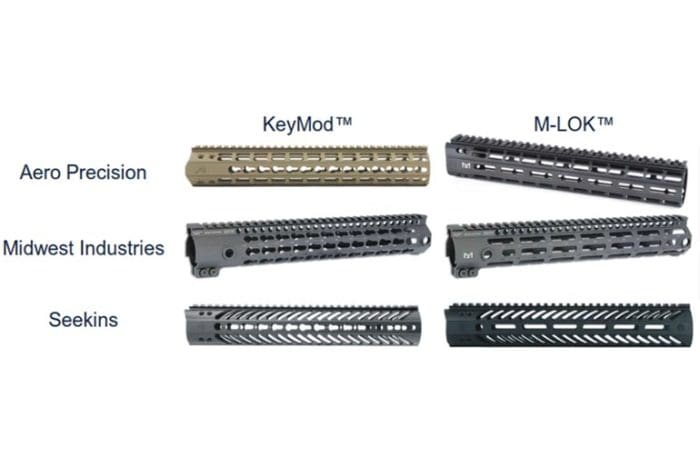If you’re looking at putting a handguard on your AR-15 that accessories can be directly attached to, it usually comes down to M-LOK vs keyword handguards. And why not? Both are well-made, and both allow you to attach just about any accessory you’d want to an AR-pattern rifle.
They aren’t lines of products so much as accessory direct attachment mounting system designs that some companies came up with, namely Magpul (M-LOK) and a joint venture (KeyMod) between VLTOR and Noveske. They’re both open-source, public domain meaning that anyone can use these designs. Anyone and their brother can (and does) make a handguard that are M-LOK or KeyMod.
You can buy the handguards themselves, such as the following M-LOK handguard from Midwest Industries:
Or this KeyMod rails handguard, also by Leapers:
Lots of gun owners prefer these to traditional quad rail. Both M-LOK and KeyMod handguards are lightweight and provide a more comfortable hold on the gun without a cheese grater effect on the support hand.
Additionally, some companies sell uppers or complete guns with M-LOK or KeyMod handguards, such as this DDM4 V7 Pro with an M-LOK handguard from Daniel Defense:
Or this barreled upper from Palmetto State Armory with KeyMod handguard:
How they work differs from your typical Picatinny rail, though plenty of M-LOK and KeyMod handguards have a Picatinny rail as well. Both systems are designs holes machined into the handguard instead of to said rail. The compatible accessories of your choice is mounted to a bracket that locks into said holes.
Depending on the handguard, you can mount accessories on the sides, bottom or top of the handguard. Why are they better than a rail? Picatinny rails require extra metal and therefore add weight. M-LOK and KeyMod direct attachment systems let you bolt whatever you want directly to the gun. Practical AND tactical!
How said M-LOK or KeyMod accessories mount depends on whether KeyMod vs M-LOK is the system you’re using.
The KeyMod system uses a system of keyholes, similar to one you’d find on a door chain. You have a large hole that the accessory lug goes into, then a smaller track.
Insert, then push and it locks in place. Tighten the lug screw and the accessory bracket is locked down. There might be one, two or three locking lugs depending on the accessory you’re mounting.
Magpul wanted to do something a little different, as they didn’t quite like how KeyMod performed. So they went to the drawing board and created a different accessory mounting system, the M-LOK. The basic idea is the same (insert mounting bracket, tighten down) but the method is different.
The M-LOK rail system uses rectangular holes machined into the handguard. The mounting bracket for your accessories (rail sections, bipod, light, whatever) has locking lugs with bi-directional swivels. They look sort of like a rectangular washer on the bottom of the lug. As you tighten the lug screw, the lug rotates.
To insert, you turn the lugs until they’re parallel to the accessory mounting bracket and the mounting holes. You simply drop the bracket in, and then tighten them down. The lugs rotate and tighten, until the lugs are perpendicular to the mounting holes and thus lock the accessory bracket in place.
Some folks might note at this point that USSOCOM – United States Special Operations COMmand, the folks who command the special forces of our military – selected M-LOK for their personnel. So if you’re the sort who is so totally an operator vouchsafing the local Walmart from ISIS and have to have the same gear…that’s what you get.
You look weird wearing a plate carrier in an office, Steve! That kind of vest is not business casual and stop complaining that there aren’t MREs in the breakroom!
But I digress.
For the typical person who wants an accessory mounting system, there are a few reasons to consider KeyMod vs M-LOK and vice versa. Granted, for most folks…it’s not going to make much difference. We get our rifle out at the range, punch some paper and go home. It’s fun!
However, there are a few things to know. The KeyMod rail system is less popular, with fewer KeyMod-compatible accessories being available. Part of the reason why Magpul came up with M-LOK to begin with is they didn’t like how KeyMod worked with accessories on polymer handguards, which the M-LOK system addresses.
Since Magpul is SO HUGE in the AR space, M-LOK has a lot more industry support with hundreds of M-LOK accessories. USSOCOM picking M-LOK as its direct attachment system of choice also makes it a bit more desirable as a group that knows what battle-worthy gear is prefers it. KeyMod fell apart under stress testing, which is something to be aware of.
Again, if you’re the average Joe or Jane…that actually matters less than you’d think. All of your shooting is going to be done at the range, so either accessory rail system will do what you need it to. If, however, you compete in 3-gun every week or are an actual uniformed officer upgrading your patrol carbine…you want the SOCOM-approved model.
What do you think though? Have a different preference? Used both and prefer one or the other? Have you finally accepted that hot wings should only come with blue cheese? Sound off in the comments!
